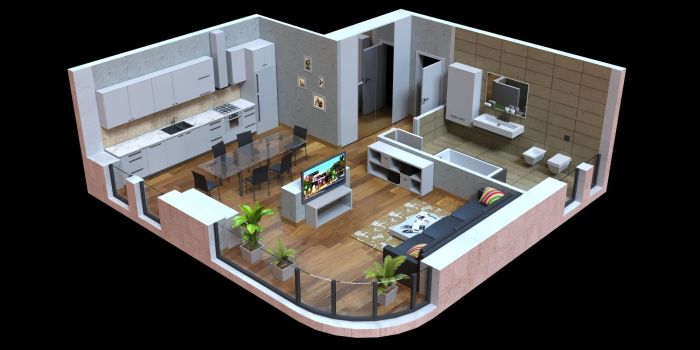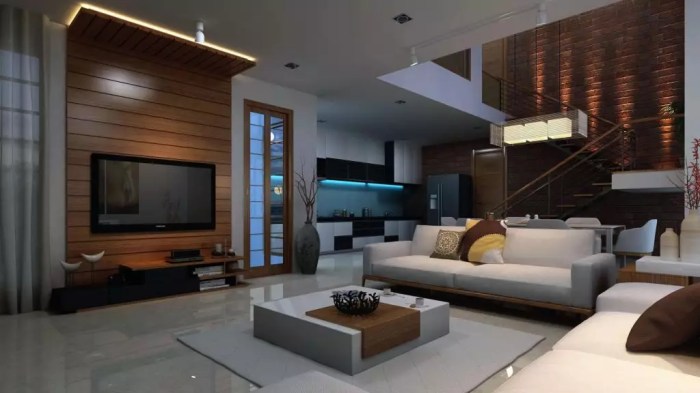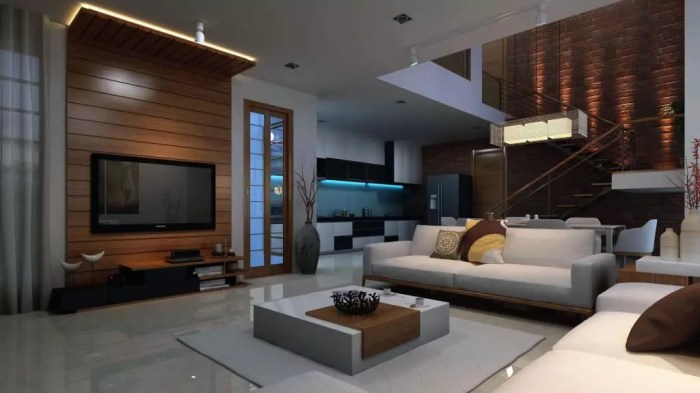3D design house interior has revolutionized the way we envision and create our living spaces. Gone are the days of relying solely on blueprints and imagination. Now, with the power of 3D software, we can experience the immersive reality of our future homes before a single brick is laid.
From crafting intricate layouts to selecting materials and finishes, 3D design empowers homeowners and designers alike to collaborate and visualize their dream spaces in stunning detail.
The process begins with understanding your needs and preferences. Through a collaborative approach, designers can translate your vision into a digital representation that captures the essence of your style. With each step, the 3D model evolves, incorporating your feedback and refining the design until it perfectly reflects your desired aesthetic and functionality.
Lighting and Color Schemes

Lighting plays a crucial role in shaping the ambiance and functionality of a space. It can influence mood, highlight architectural features, and enhance the overall visual appeal of an interior. Proper lighting design is essential for creating a welcoming and comfortable environment.
Lighting Schemes for Different Spaces
Different lighting schemes are best suited for different spaces based on their function and desired atmosphere. For example, a living room typically requires a combination of ambient, task, and accent lighting to create a versatile space for relaxation, entertainment, and reading.
In contrast, a bedroom might prioritize softer, more intimate lighting for a calming and relaxing ambiance.
Living Room Lighting
- Ambient Lighting:This provides general illumination throughout the room, creating a base level of brightness. It can be achieved using overhead fixtures such as chandeliers, pendant lights, or recessed lights.
- Task Lighting:This focuses light on specific areas for activities like reading or working. Table lamps, floor lamps, and under-cabinet lights are examples of task lighting.
- Accent Lighting:This highlights specific features or objects in the room, adding visual interest and depth. It can be achieved using spotlights, wall sconces, or track lighting.
Bedroom Lighting
- Ambient Lighting:A dimmer switch on an overhead fixture allows for adjusting the brightness level to create a relaxing atmosphere.
- Task Lighting:A bedside lamp provides light for reading in bed, while a small desk lamp can be used for working or applying makeup.
- Accent Lighting:Recessed lighting can highlight artwork or architectural details, while a string of fairy lights can add a touch of whimsy and romance.
Color Palette and Psychological Effects
Color palettes can significantly impact the mood and atmosphere of a space. Different colors evoke different emotions and associations, and understanding these psychological effects can help you create a desired ambiance.
| Color Palette | Psychological Effects |
|---|---|
| Warm Colors (Red, Orange, Yellow) | Stimulating, energetic, inviting, can create a sense of warmth and comfort. |
| Cool Colors (Blue, Green, Purple) | Calming, relaxing, serene, can create a sense of peace and tranquility. |
| Neutral Colors (White, Gray, Black) | Versatile, can create a sense of spaciousness and cleanness. |
3D Visualization and Presentation: 3d Design House Interior
D visualization is a powerful tool for interior designers, allowing them to bring their design concepts to life and communicate their vision effectively to clients. It helps create a realistic and immersive experience, bridging the gap between the designer’s imagination and the client’s understanding.
The Importance of 3D Visualization, 3d design house interior
D visualization plays a crucial role in presenting design concepts, enhancing client communication and facilitating informed decision-making.
3D design allows you to visualize your dream home interior, no matter the size. Even in a compact space like a 22 sqm house , you can create a functional and stylish design. By using 3D software, you can experiment with different layouts, furniture arrangements, and color palettes to find the perfect solution for your needs.
- Enhanced Communication:3D visualizations provide a tangible representation of the design, enabling clients to visualize the space and understand the proposed design elements, textures, and lighting. This helps avoid misinterpretations and ensures a shared understanding of the final outcome.
- Improved Decision-Making:3D visualizations allow clients to experience the space virtually, enabling them to explore different design options, experiment with furniture arrangements, and make informed decisions about materials, colors, and finishes.
- Increased Client Satisfaction:By showcasing a realistic representation of the final design, 3D visualizations help manage client expectations, reduce surprises, and increase client satisfaction with the final project.
3D Walkthroughs
A 3D walkthrough is a dynamic and interactive presentation method that allows clients to explore the designed space virtually. This immersive experience provides a realistic and engaging perspective, enhancing the understanding and appreciation of the design.
- Creating a 3D Walkthrough:3D walkthroughs are created using specialized software, such as 3ds Max, Lumion, or Unreal Engine. These software programs enable the creation of detailed 3D models, textures, lighting, and animations. The designer can then navigate through the virtual space, creating a seamless and engaging experience.
- Benefits of 3D Walkthroughs:3D walkthroughs offer several advantages, including:
- Immersive Experience:The ability to move through the space virtually creates a realistic and immersive experience, allowing clients to visualize the flow, scale, and ambiance of the design.
- Detailed Exploration:Clients can explore every nook and cranny of the space, examining details that might be difficult to grasp from static renderings.
- Enhanced Visualization:3D walkthroughs enable clients to visualize the space from multiple perspectives, providing a comprehensive understanding of the design.
Presentation Methods
There are various presentation methods used in 3D visualization, each offering unique advantages:
- 3D Renderings:3D renderings are static images that capture the design in a high-quality and photorealistic manner. They provide a clear and detailed representation of the space, showcasing the design elements, materials, and lighting.
- Virtual Reality Tours:Virtual reality tours provide an even more immersive experience, allowing clients to explore the designed space in a virtual environment using VR headsets. This technology offers a truly interactive and engaging experience, enabling clients to feel present in the space and experience it from multiple perspectives.
Collaboration and Communication

Effective communication between the designer and client is crucial for successful interior design projects. Clear and consistent communication ensures that the designer understands the client’s vision, needs, and preferences, while the client feels informed and involved throughout the design process.
This collaborative approach fosters trust and ultimately leads to a more satisfying outcome for both parties.
D models serve as a powerful tool to facilitate better communication and collaboration in interior design.
Visualizing Design Concepts
Visualizing design concepts in 3D allows clients to experience the proposed space in a realistic and immersive way. This visual representation goes beyond traditional 2D plans and sketches, enabling clients to understand the layout, scale, and overall ambiance of the design.
Clients can easily grasp the flow of space, the placement of furniture, and the impact of different color schemes and materials. This enhanced understanding fosters a shared vision and minimizes misunderstandings, leading to more efficient and productive collaboration.
Providing Clear Feedback
D models provide a common ground for client feedback and revisions. Clients can easily identify areas they want to change, whether it’s the placement of a sofa, the color of a wall, or the type of lighting fixture. This visual feedback loop helps refine the design iteratively, ensuring that the final product aligns perfectly with the client’s vision.
“3D models serve as a visual language that everyone can understand, regardless of their technical background.”
Streamlining the Design Process
D models help streamline the design process by minimizing the need for multiple rounds of revisions based on verbal descriptions. Clients can see the impact of changes in real-time, leading to faster decision-making and a more efficient workflow.
Closing Notes

As technology continues to advance, the possibilities within 3D home interior design are boundless. From virtual reality walkthroughs that allow you to explore your future home before it’s built to augmented reality applications that enable you to see furniture and décor in your existing space, the future of home design is truly exciting.
3D design empowers us to not only create beautiful and functional spaces but also to experience them in a way that was previously unimaginable.
Answers to Common Questions
What are the most popular 3D design software programs?
Some of the most widely used 3D design software programs include SketchUp, Autodesk Revit, and Lumion. These programs offer a range of features and capabilities to suit different skill levels and design needs.
How much does it cost to hire a 3D home interior designer?
The cost of hiring a 3D home interior designer can vary depending on factors such as the size of the project, the designer’s experience, and the location. It’s recommended to get quotes from multiple designers to compare pricing and services.
Can I create my own 3D home interior design using online tools?
Yes, there are several online tools and platforms available that allow you to create basic 3D models of your home interior. These tools may be suitable for simple projects or as a starting point for more complex designs.
What are the benefits of using 3D design for home interiors?
3D design offers numerous benefits, including enhanced visualization, improved communication, reduced errors, and the ability to explore different design options before committing to any decisions.
